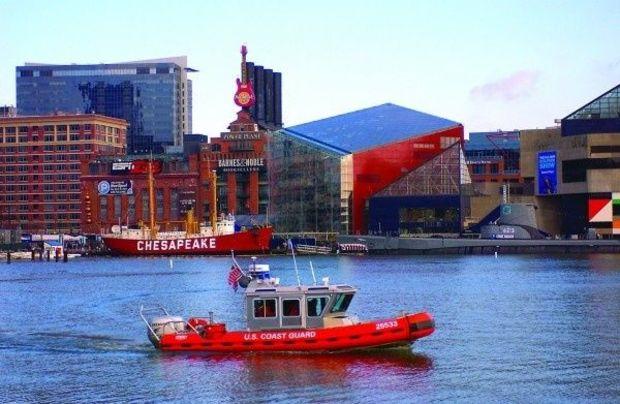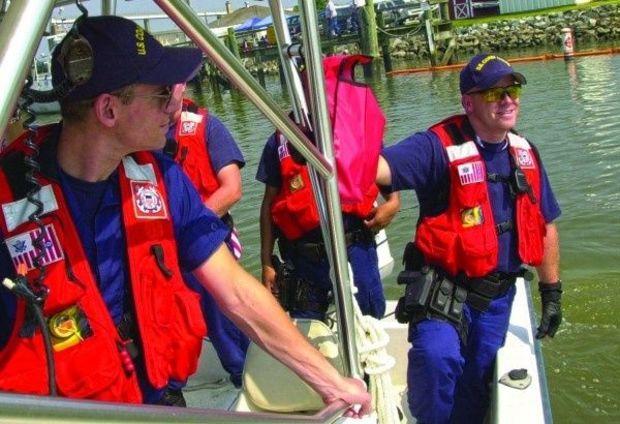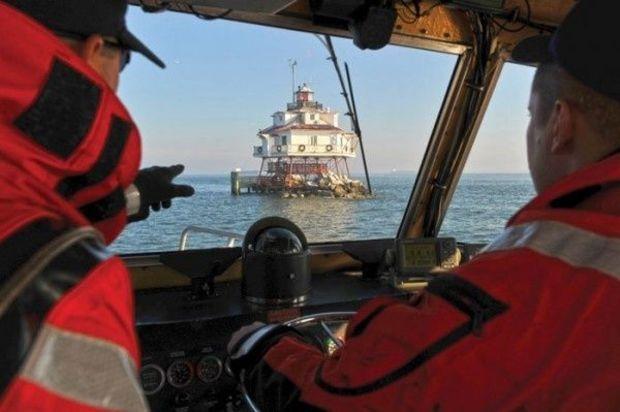It’s late Tuesday night, and a colorless, 38-foot Chesapeake Bay workboat chugs quietly into the harbor and heads for a pier near a cluster of oil-storage tanks. Cramped inside the darkened wheelhouse are four men—the skipper, a deckhand, and two explosives experts—on a clandestine mission.
Within seconds after the vessel ties up, the crew detonates its hidden cargo—a diesel fuel bomb with plastic explosives—turning the shoreside oil tanks into an inferno and giving the city its first taste of maritime terrorism. The port is shut for days, and shipping near other major U.S. harbors, hampered by new emergency security restrictions, slows to a crawl.

No such disaster has yet befallen a U.S. port or potential waterfront target, including those on the Chesapeake Bay, and federal and state intelligence officials have found no credible evidence that one is in the offing. But the U.S. Coast Guard (USCG) and Maryland Natural Resources Police (NRP) are asking boaters to stay alert to help make sure one never takes place.
“Right now there’s nothing apparent, but it’s a real threat,” says Robert M. Gauvin, the point-man on the small-boat security issue at USCG headquarters in Washington. As the U.S. has learned since the September 11, 2001 terrorist attacks, it only takes one slip-up to enable a lone suicide bomber or small group of people to inflict a lot of damage.
In brief, officials want boaters to keep their eyes open for unusual or suspicious activities on the Bay, such as unusually intensive diving operations around big ships and near critical infrastructure such as wharves, bridges, and dams; odd-hours transfer of people from freighters and tankers onto small boats; or vessels operating at night without running lights.

USCG asks boaters who observe such activity to report it to the National Response Center at (877) 249-2824. The Maryland NRP maintains a hotline at (800) 638-9944. Or you can phone USCG’s Baltimore command center at (410) 576-2525. In a pinch, call USCG or Natural Resources Police on Channel 16 of your VHF-FM marine radio.
Both the Coast Guard and other law-enforcement authorities have stepped up their intelligence gathering over the past several years, keeping closer tabs on small-boat traffic; increasing their random boardings; and information sharing with counterpart agencies. New high-tech vessel identification systems help to keep better tabs on water traffic.
USCG has launched a program called America’s Waterways Watch (AWW) designed to encourage ordinary boaters to report incidents that they believe may suggest terrorism or illegal activity. And the Maryland NRP has a similar program dubbed “See Something, Say Something.”
As is often the case in following up on tips from citizens, some of the reports from boaters have turned out to be erroneous, such as a Maryland case a few years ago in which the suspected “terrorists” turned out to be ordinary fishermen. But authorities say they’d rather get such reports and run them down than not know about them and risk a serious incident.
“Intelligence is going to win this battle,” says Stephen L. Caldwell, former director of homeland security and justice issues for the Government Accountability Office (GAO), the congressional watchdog agency, who has delved into the small-boat security issue extensively and still keeps tabs on it.
It doesn’t take much to appreciate the potential of the small-boat threat. Authorities cite the October 2000 attack on the
USS Cole, in which terrorists in the Yemini port of Aden used a small boat to approach the port side of the American destroyer—and set off an explosion that blew a large hole in the warship’s side and killed 17 U.S. sailors.

In August 2005, terrorists fired rocket-propelled grenades at two U.S. warships moored in Aqaba, Jordan. In November of that year, pirates attacked a cruise liner 100 miles off the coast of Somalia, using two 25-foot rigid inflatable boats.
Small recreational boats and commercial vessels are easy to buy or rent—or even commandeer—in the United States. There are more than 20 million pleasure craft, 300,000 fishing boats, and 100,000 other small commercial vessels. Unlike aircraft, most don’t require a license to operate. They can easily deliver weapons or people.
“Small boats require low investment and minimal training to achieve even partial terrorism goals,” Jena Baker McNeill says in a report for the Heritage Foundation, a Washington think-tank.
Even so, GAO investigations have shown that the Department of Homeland Security still has a long way to go in taking steps to enable its disparate agencies to share and coordinate the intelligence they receive and to track what’s being done about it.
Officials say that makes it all the more important for recreational boaters—who are out on the water frequently and can observe what’s going on—to call the hotline numbers when they see suspicious activity.
Where to Report Suspicious Activity:
USCG National Response Center Waterway Watch (877) 249-2824
Maryland NRP Hotline (800) 638-9944
USCG Baltimore Command Center (410) 576-2525
USCG or NRP on VHF-FM Channel 16
About the author: Art Pine is a Coast-Guard-licensed captain and a longtime boater on the Chesapeake Bay. An early version of this article appeared in Mad Mariner, a defunct online boating magazine.
 No such disaster has yet befallen a U.S. port or potential waterfront target, including those on the Chesapeake Bay, and federal and state intelligence officials have found no credible evidence that one is in the offing. But the U.S. Coast Guard (USCG) and Maryland Natural Resources Police (NRP) are asking boaters to stay alert to help make sure one never takes place.
“Right now there’s nothing apparent, but it’s a real threat,” says Robert M. Gauvin, the point-man on the small-boat security issue at USCG headquarters in Washington. As the U.S. has learned since the September 11, 2001 terrorist attacks, it only takes one slip-up to enable a lone suicide bomber or small group of people to inflict a lot of damage.
In brief, officials want boaters to keep their eyes open for unusual or suspicious activities on the Bay, such as unusually intensive diving operations around big ships and near critical infrastructure such as wharves, bridges, and dams; odd-hours transfer of people from freighters and tankers onto small boats; or vessels operating at night without running lights.
No such disaster has yet befallen a U.S. port or potential waterfront target, including those on the Chesapeake Bay, and federal and state intelligence officials have found no credible evidence that one is in the offing. But the U.S. Coast Guard (USCG) and Maryland Natural Resources Police (NRP) are asking boaters to stay alert to help make sure one never takes place.
“Right now there’s nothing apparent, but it’s a real threat,” says Robert M. Gauvin, the point-man on the small-boat security issue at USCG headquarters in Washington. As the U.S. has learned since the September 11, 2001 terrorist attacks, it only takes one slip-up to enable a lone suicide bomber or small group of people to inflict a lot of damage.
In brief, officials want boaters to keep their eyes open for unusual or suspicious activities on the Bay, such as unusually intensive diving operations around big ships and near critical infrastructure such as wharves, bridges, and dams; odd-hours transfer of people from freighters and tankers onto small boats; or vessels operating at night without running lights.
 USCG asks boaters who observe such activity to report it to the National Response Center at (877) 249-2824. The Maryland NRP maintains a hotline at (800) 638-9944. Or you can phone USCG’s Baltimore command center at (410) 576-2525. In a pinch, call USCG or Natural Resources Police on Channel 16 of your VHF-FM marine radio.
Both the Coast Guard and other law-enforcement authorities have stepped up their intelligence gathering over the past several years, keeping closer tabs on small-boat traffic; increasing their random boardings; and information sharing with counterpart agencies. New high-tech vessel identification systems help to keep better tabs on water traffic.
USCG has launched a program called America’s Waterways Watch (AWW) designed to encourage ordinary boaters to report incidents that they believe may suggest terrorism or illegal activity. And the Maryland NRP has a similar program dubbed “See Something, Say Something.”
As is often the case in following up on tips from citizens, some of the reports from boaters have turned out to be erroneous, such as a Maryland case a few years ago in which the suspected “terrorists” turned out to be ordinary fishermen. But authorities say they’d rather get such reports and run them down than not know about them and risk a serious incident.
“Intelligence is going to win this battle,” says Stephen L. Caldwell, former director of homeland security and justice issues for the Government Accountability Office (GAO), the congressional watchdog agency, who has delved into the small-boat security issue extensively and still keeps tabs on it.
It doesn’t take much to appreciate the potential of the small-boat threat. Authorities cite the October 2000 attack on the USS Cole, in which terrorists in the Yemini port of Aden used a small boat to approach the port side of the American destroyer—and set off an explosion that blew a large hole in the warship’s side and killed 17 U.S. sailors.
USCG asks boaters who observe such activity to report it to the National Response Center at (877) 249-2824. The Maryland NRP maintains a hotline at (800) 638-9944. Or you can phone USCG’s Baltimore command center at (410) 576-2525. In a pinch, call USCG or Natural Resources Police on Channel 16 of your VHF-FM marine radio.
Both the Coast Guard and other law-enforcement authorities have stepped up their intelligence gathering over the past several years, keeping closer tabs on small-boat traffic; increasing their random boardings; and information sharing with counterpart agencies. New high-tech vessel identification systems help to keep better tabs on water traffic.
USCG has launched a program called America’s Waterways Watch (AWW) designed to encourage ordinary boaters to report incidents that they believe may suggest terrorism or illegal activity. And the Maryland NRP has a similar program dubbed “See Something, Say Something.”
As is often the case in following up on tips from citizens, some of the reports from boaters have turned out to be erroneous, such as a Maryland case a few years ago in which the suspected “terrorists” turned out to be ordinary fishermen. But authorities say they’d rather get such reports and run them down than not know about them and risk a serious incident.
“Intelligence is going to win this battle,” says Stephen L. Caldwell, former director of homeland security and justice issues for the Government Accountability Office (GAO), the congressional watchdog agency, who has delved into the small-boat security issue extensively and still keeps tabs on it.
It doesn’t take much to appreciate the potential of the small-boat threat. Authorities cite the October 2000 attack on the USS Cole, in which terrorists in the Yemini port of Aden used a small boat to approach the port side of the American destroyer—and set off an explosion that blew a large hole in the warship’s side and killed 17 U.S. sailors.
 In August 2005, terrorists fired rocket-propelled grenades at two U.S. warships moored in Aqaba, Jordan. In November of that year, pirates attacked a cruise liner 100 miles off the coast of Somalia, using two 25-foot rigid inflatable boats.
Small recreational boats and commercial vessels are easy to buy or rent—or even commandeer—in the United States. There are more than 20 million pleasure craft, 300,000 fishing boats, and 100,000 other small commercial vessels. Unlike aircraft, most don’t require a license to operate. They can easily deliver weapons or people.
“Small boats require low investment and minimal training to achieve even partial terrorism goals,” Jena Baker McNeill says in a report for the Heritage Foundation, a Washington think-tank.
Even so, GAO investigations have shown that the Department of Homeland Security still has a long way to go in taking steps to enable its disparate agencies to share and coordinate the intelligence they receive and to track what’s being done about it.
Officials say that makes it all the more important for recreational boaters—who are out on the water frequently and can observe what’s going on—to call the hotline numbers when they see suspicious activity.
Where to Report Suspicious Activity:
USCG National Response Center Waterway Watch (877) 249-2824
Maryland NRP Hotline (800) 638-9944
USCG Baltimore Command Center (410) 576-2525
USCG or NRP on VHF-FM Channel 16
About the author: Art Pine is a Coast-Guard-licensed captain and a longtime boater on the Chesapeake Bay. An early version of this article appeared in Mad Mariner, a defunct online boating magazine.
In August 2005, terrorists fired rocket-propelled grenades at two U.S. warships moored in Aqaba, Jordan. In November of that year, pirates attacked a cruise liner 100 miles off the coast of Somalia, using two 25-foot rigid inflatable boats.
Small recreational boats and commercial vessels are easy to buy or rent—or even commandeer—in the United States. There are more than 20 million pleasure craft, 300,000 fishing boats, and 100,000 other small commercial vessels. Unlike aircraft, most don’t require a license to operate. They can easily deliver weapons or people.
“Small boats require low investment and minimal training to achieve even partial terrorism goals,” Jena Baker McNeill says in a report for the Heritage Foundation, a Washington think-tank.
Even so, GAO investigations have shown that the Department of Homeland Security still has a long way to go in taking steps to enable its disparate agencies to share and coordinate the intelligence they receive and to track what’s being done about it.
Officials say that makes it all the more important for recreational boaters—who are out on the water frequently and can observe what’s going on—to call the hotline numbers when they see suspicious activity.
Where to Report Suspicious Activity:
USCG National Response Center Waterway Watch (877) 249-2824
Maryland NRP Hotline (800) 638-9944
USCG Baltimore Command Center (410) 576-2525
USCG or NRP on VHF-FM Channel 16
About the author: Art Pine is a Coast-Guard-licensed captain and a longtime boater on the Chesapeake Bay. An early version of this article appeared in Mad Mariner, a defunct online boating magazine.